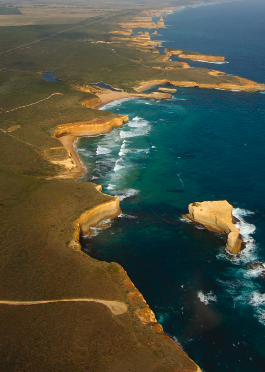 Music? Check. Sun lotion? Check. Set of wheels? Check. Ready for one of the world’s greatest road-trips? GUM asks you to buckle up for the road-trip in the land down under. Just don’t forget the camera or the shades.
Music? Check. Sun lotion? Check. Set of wheels? Check. Ready for one of the world’s greatest road-trips? GUM asks you to buckle up for the road-trip in the land down under. Just don’t forget the camera or the shades.
The Great Ocean Road on Australia’s south-eastern coastline is the ultimate road-trip. The 160 mile stretch offers extraordinary views with charming towns and villages to be explored along the way. Wind down your windows, turn up the music, sit back, relax and take in the outstanding scenery and smell the sea air.
Despite repeatedly being voted as one of the World’s Greatest Drives, the Great Ocean Road is often overshadowed by Australia’s more popular tourist locations. Every year, Australia welcomes five million tourists with approximately 800,000 arriving from British shores. Enticed by the warmer climate, laid-back lifestyle and white sandy beaches, most arrive in Sydney before trekking north up the east-coast tourist-trail. With many visitors facing time and money constraints, the Great Ocean Road in the southern state of Victoria is often neglected and, as a result, it offers a very different type of holiday.
The towns are smaller and the beaches are quieter; there are more campsites than hotels and in some places you won’t be able to get food, or a drink, past 9pm. You’re also more likely to bump into Aussie families and their caravans than you are some fellow British backpackers.
The single-lane, winding road clings to cliff-tops providing panoramic views over the Southern Ocean. Built in the 1930s as a memorial to Australia’s fallen war servicemen of World War I, it officially begins near Torquay on Victoria’s southern coast, and ends at the small regional city of Warrnambool. However, it is common for travellers to start their journey in Melbourne, ending in the South Australian capital of Adelaide.
For many, the highlight of their trip is the Twelve Apostles; giant rock stacks reaching 70 metres high, created by constant erosion of the limestone cliffs. As the stormy Southern Ocean and blasting winds gradually eroded the softer limestone, caves were formed which eventually became arches. When they collapsed, rock stacks were left isolated from the shore. The views are particularly stunning at sunrise and sunset. If you’re feeling flush, you can take in the awesome sight from a helicopter ride, or alternatively, various viewing platforms have been erected to provide the postcard-perfect picture. You can also walk along the beach to take in these natural wonders. You will definitely not be disappointed.
Dotted along the Great Ocean Road are several coastal towns worth exploring. There are interesting locally-owned shops and quaint restaurants, and you can lay your towel on a beautiful deserted beach and soak up the sun’s rays (through your SPF 30, of course).
Torquay is famous for Bells Beach on its outskirts which hosts the world’s longest running surfing competition every Easter, attracting top surfers from around the world. Further along, part of the Road passes through the Great Otway National Park where the coastal view is matched with the Otway Ranges providing a spectacular backdrop. There is also Cape Otway Light-station, which you may know as ‘the Round-The-Twist Lighthouse’. Made famous by the popular 1990s children’s TV programme, it is the oldest surviving lighthouse in mainland Australia and has been in continuous operation since 1848. You can drive right to it, singing the theme tune along the way.
Public transport to and along the Great Ocean Road is almost non-existent with local buses running irregularly. Several travel operators provide tours making pit-stops at major sites and you can take a one day bus trip from Melbourne or a tour which lasts a few days. To truly experience the Great Ocean Road however, you should drive. Renting your own vehicle will allow you to travel at your own pace (and play your own music). Cars and campervans can be rented in either Melbourne or Adelaide from as little as £15 a day with major companies allowing you to drop off the vehicle at your destination, rather than having to make the return trip.
The journey is enjoyable all year-round, however, the time of year you travel will determine to your style of holiday. In the summer months (November- February), there are plenty of out-door activities including bushwalking, hand-gliding, abseiling, bird watching and horse riding along the beach. There are also numerous water sports. In winter (May-September), the south-eastern coast of Australia can be deceptively cold and so camping would not be for the faint-hearted. Alternatively you can find solace in cosy cabins with open fires and watch the Southern Right Whales, which only frequent the southern coast in the winter months to bear their young. Regardless of the time of year you visit, your trip will be a memorable one. Get your play-list sorted, and hit the road.

